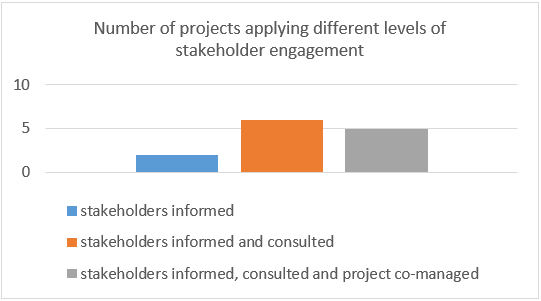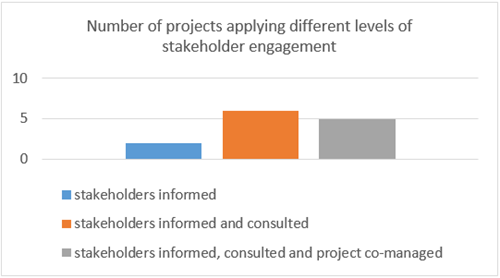Existing PLRs recognize the right to public participation in decision-making. For example, a key element of the implementation strategy for the National Development Plan 2017-2021 is to enhance participation of stakeholders in policy formulation and implementation. According to the Plan, “the adoption of a new Planning Act and the establishment of new procedures and institutions should enable active participation in both the sectoral and regional planning”.
The main policy objective of the National Forest Policy is the participation of ITPs in activities in and around their lands, on the basis of full information and sharing in the benefits and proceeds thereof. However, PLRs do not define a clear process for public authorities to carry out consultations, including the process for addressing inputs received from the consultations.
The NIMOS ESIA Guidelines[1] include concrete levels of public participation and addresses consultation and public participation. With the adoption of the Environmental Framework Law these guidelines will have a legally mandatory basis. The Draft Environmental Impact Assessment (EIA) State Order 2019 also includes a clear process to carry out consultations as well as a process to address inputs received from consultations.
The National REDD+ Strategy includes several measures on engaging ITPs in law- and decision-making processes, clarifying land rights and fostering the principles of FPIC. For example, measure 2.A.2 Preparation and Approval of an Environmental Framework Act with Environmental Impact Assessment procedures as part thereof and 2.A.4, which aims at strengthening capacity of indigenous and tribal peoples (ITPs) in forest governance. Other relevant measures in the context are 2.A.3 and 2.B.2.
The Draft Law Collective Rights ITPs 2019, in Article 4, states that ITPs have the right to full participation in decision-making processes concerning projects, programs, administrative measures, policies or other measures that significantly affect their life and / or their rights.
In Article 13, the Draft Law Collective Rights ITPs 2019, states that FPIC is required at each stage of a proposed project, program, policy or other measure that may affect the living conditions/ the rights of ITPs. The procedure for obtaining FPIC and objection options against the decision will be further detailed by the Indigenous and Tribal Peoples themselves in an FPIC Protocol that will be established within 12 months of the entry into force of the law.
There is currently no PLR that defines/creates a GRM; however, development of a REDD+ specific GRM is underway.
[1] NIMOS. 2009. Environmental Assessment Guidelines Volume I: Generic. Paramaribo, Suriname: National Institute for Environment and Development in Suriname (NIMOS).
PLRs
- Constitution
- Development Plan
- Draft Environmental Law
- Draft Environmental Impact Assessment state Order 2019
- Law on Regional Bodies
- National Forest Policy
- National REDD+ Strategy
Conventions




